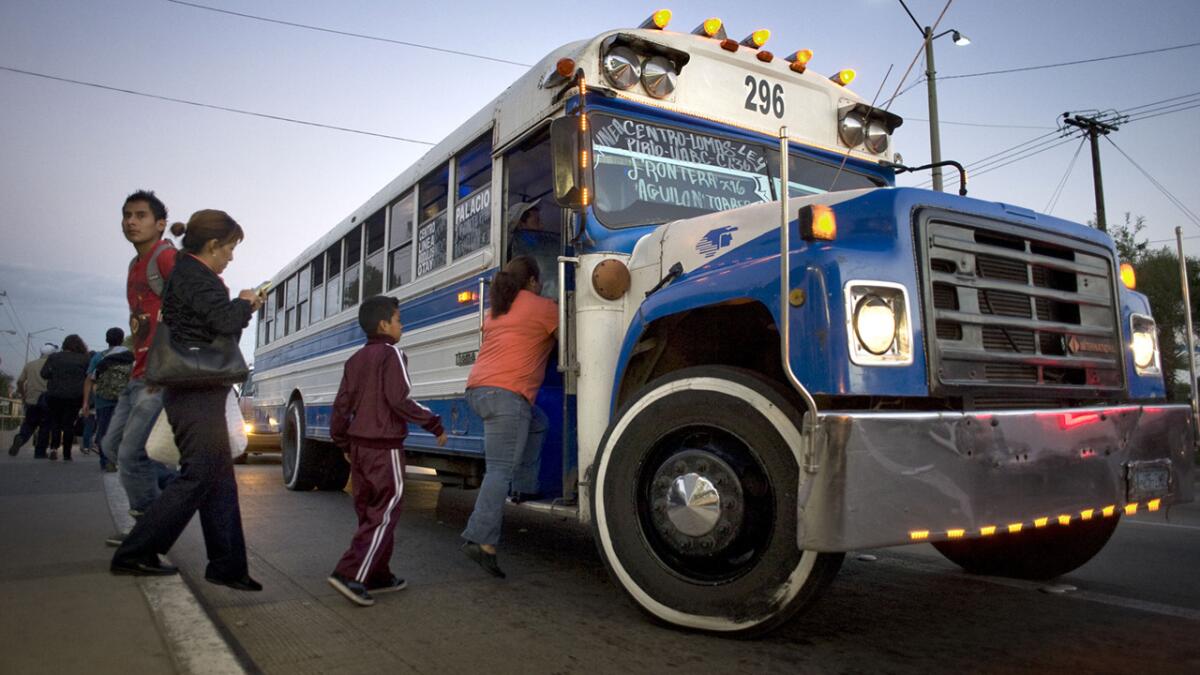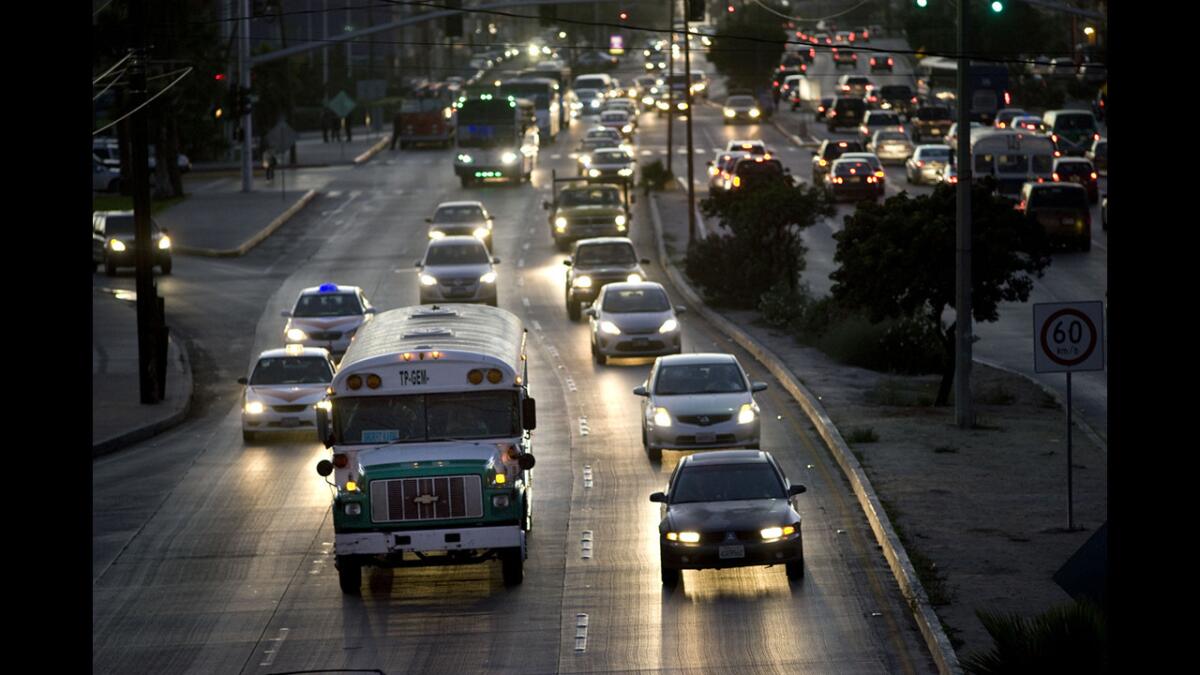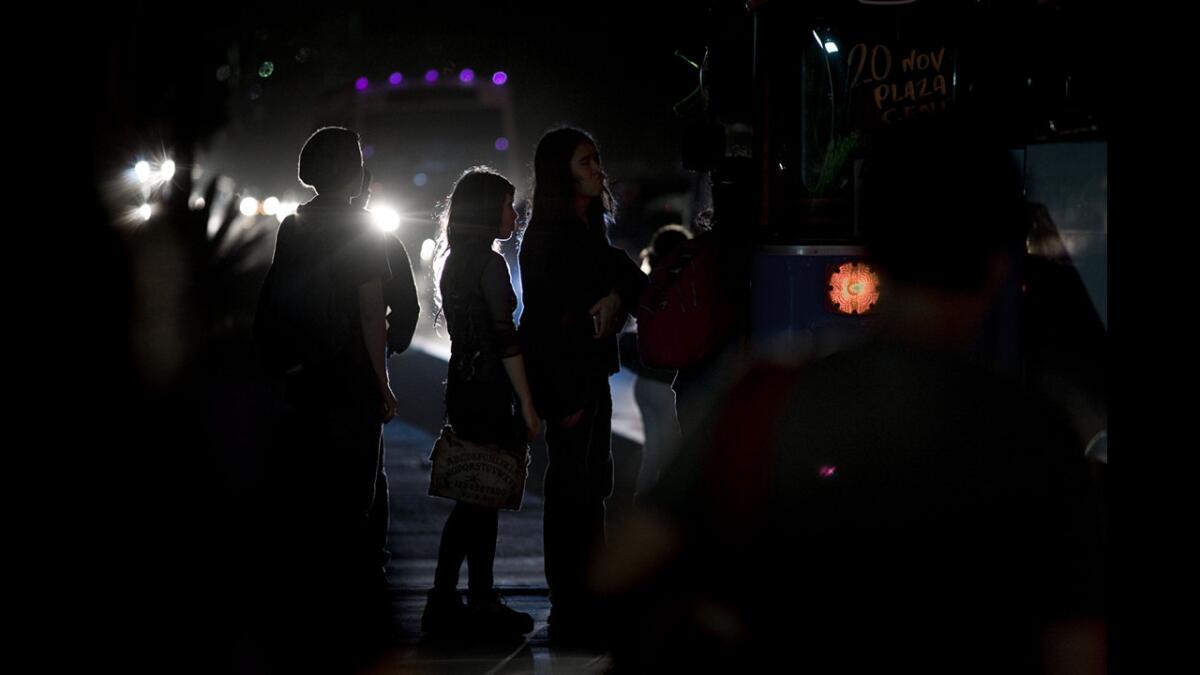Tijuana turns to Bus Rapid Transit for faster, cheaper service

Riders board a bus in front of the Universidad Autonoma de Baja California in Tijuana. A future Bus Rapid Transit system is expected to eventually replace older buses throughout the city.
- Share via
Reporting from Tijuana — Given a choice, few passengers would willingly board Tijuana’s ragtag fleet of multicolored buses that crowd the city’s major thoroughfares. Riders complain they’re old, inefficient, slow, uncomfortable — and expensive. They say that service can be spotty, unsafe, and at rush hour, overcrowded.
Now, after years of false starts, Tijuana is moving forward on a major overhaul of its public transportation system, often criticized as serving political interests rather than its 1 million daily users. Next fall, a Bus Rapid Transit (BRT) system is expected to start service to some 300,000 passengers a day, the first step in a plan that aims to modernize public transportation in the entire city.

Next fall, a Bus Rapid Transit system is expected to start service to some 300,000 passengers a day, the first step in a plan that aims to modernize public transportation in Tijuana.
Passengers will pay through Smart Cards, and for a single fare of about 14 pesos — less than a dollar — they’ll be able to transfer without extra charge. The service will be safer, cheaper, faster and more comfortable, city officials say, with stations offering free Internet service. The system will create new economic zones along the way, they hope, as people invest in shops, restaurants and other businesses.
“It will transform the city,” said Alonso Lopez Sepulveda, the man who now heads up Sistema Integral De Transporte Tijuana, SITT, a semi-autonomous municipal agency that is spearheading the creation of Tijuana’s BRT.
BRTs are bus systems conceived as above-ground metro systems adapted to meet the needs of the cities they serve. They typically include such features as stations where passengers pay before boarding, a centralized control and monitoring system, and dedicated lanes or routes that allow buses to avoid the congestion of city streets.
The heart of the Tijuana system will be a 23-mile route that runs from the San Ysidro border to the eastern part of the city and back. Known as La Ruta Troncal, or the trunk route, it will run down Avenida Revolucion, to the Rio Zone, and down the Via Rapida, highways that flank the Tijuana River channel.

The Tijuana Bus Rapid Transit system will be safer, cheaper, faster and more comfortable, city officials say, with stations offering free Internet service.
Planners say it will connect the city’s center, with its restaurants, shops and cultural offerings, to the sprawling working-class neighborhoods of eastern Tijuana.
The trunk route would be fed by a system of feeder routes reaching into dozens of neighborhoods across the city.
The new system is being designed with 45 stations, including two major terminals, one at the eastern end on Bulevar Insurgentes, and another near the border in downtown Tijuana. The city is planning a bridge linking Tijuana’s border area to the downtown terminal. Along other parts of the route, the project includes eight new pedestrian bridges and the rebuilding of seven others.
“This is a solution that can greatly improve the mobility of Tijuana’s residents, in a way that is much less costly than a metro-type system,” said Luis Felipe Siqueiros, a Guadalajara-based transportation consultant who has been advising the city on the new system. “I think the city is taking a big step forward with this project.”

Passengers will pay through Smart Cards, and for a single fare of less than a dollar, they will be able to transfer without extra charge.
According to the World Resources Institute, a non-governmental research group based in Washington, Tijuana will join close to 200 cities worldwide with BRT systems, with more than 60% of the ridership in Latin America, where the first systems were launched in the 1970s. Starting in 2003 with Leon, Guanajuato, several Mexican cities now have adopted BRT systems, including Mexico City, Guadalajara and Chihuahua.
“We haven’t reinvented the wheel here,” said Lopez. “We are implementing a system adapted to Tijuana. The transportation companies have been told that it’s worth it; it will eliminate a lot of headaches.”
Planners say Bus Rapid Transit can become a key connector for Tijuana, where much of the growth of recent years has been channeled into sprawling housing developments at the city’s edge.
“This creates great mobility challenges,” said Fernando Paez, director of transport systems for Embarq Mexico, a program of the World Resources Institute.
For Erik Garcia, a 22-year-old pharmacy student at the Autonomous University of Baja California, traveling between his home in Tijuana’s Fundadores area and his classes on the school’s campus near the Otay Mesa border takes three hours a day.
“There ought to be a schedule, that the drivers would have to meet, not just when they feel like it,” said Garcia, who often opts for more expensive collective taxis to save time, spending about 50 pesos a day, or more than $3.
At rush hour Wednesday night, dozens of buses and vans vied for passengers at La Cinco y Diez, the chaotic intersection of two major thoroughfares.
“It’s the worst, horrible; 90% of the drivers don’t know how to drive,” said Cristian Robles, a 24-year-old manufacturing worker preparing to board a public bus after being dropped off by his company.
Tijuana’s mass transit system today consists of private companies that operate under a municipal concession, with many vehicles being used school buses and old public transit buses that are brought to Mexico. The city has 3,600 buses operated by a dozen companies that travel 120 routes, said Paez, of the World Resources Institute.
“Tijuana has many transportation companies that compete with each other,” said Siqueiros, the consultant.
The city also has a large fleet of collective taxis — 33 transportation groups representing 127 routes, Paez said. But these will continue their operations for the time being, serving the city’s numerous colonias, Lopez said.
“The collective taxis would be incorporated in a second phase,” Lopez said. “Bit by bit, the government will create routes, integrating them into the system.”
Launching the first phase is costing close to $72 million to build bridges, stations, roadways, ramps, staircases and a fiber optic system, with the city and federal government sharing the expense. Lopez said an additional $84 million would be spent on 546 buses, paid for by the city’s 12 private transportation companies, which will be in charge of jointly operating the system.
Getting the buy-in of the local transportation companies, many of them controlled by unions affiliated with political parties, has involved extensive negotiations with the companies and Mayor Jorge Astiazaran’s administration.
To date, seven of the 12 companies with municipal concessions have signed letters of intent agreeing to be part of the mega-company that will operate the new system, a city spokesman said.
Sandra Dibble is a reporter for the San Diego Union-Tribune, which is part of the California News Group.
More to Read
Sign up for Essential California
The most important California stories and recommendations in your inbox every morning.
You may occasionally receive promotional content from the Los Angeles Times.










